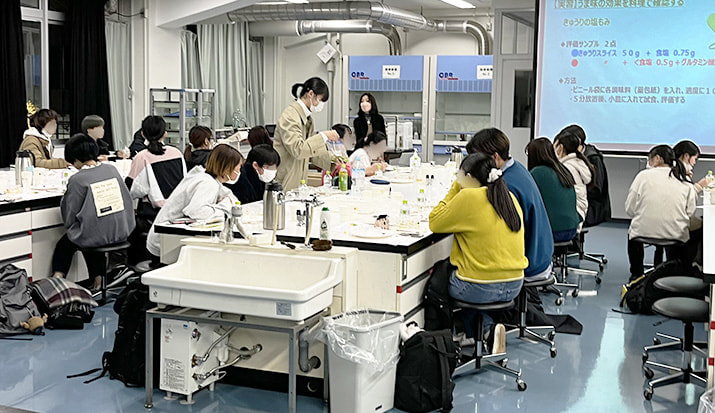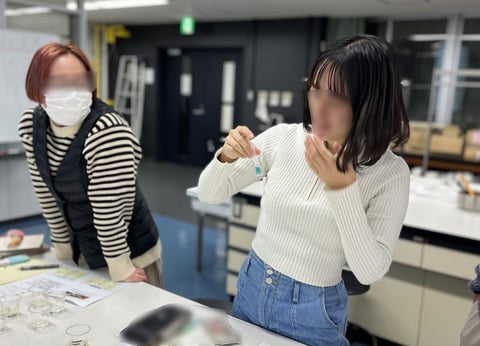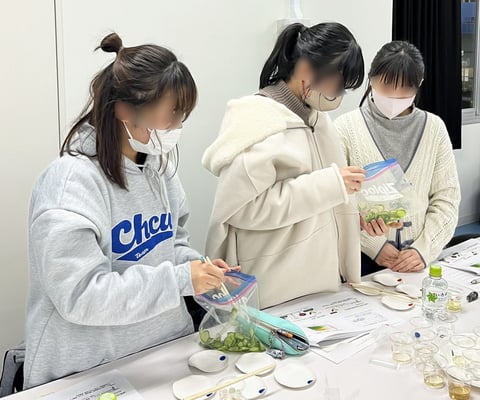Umami Lecture “Dashi and Umami” in Tohoku University
January 2024

Dashi which is made from katsuobushi and kombu is the most common dashi that every Japanese has tasted. So, have you ever consciously tasted katsuo dashi and kombu dashi separately? University students took part in a practical works on dashi.
On January 11, 2024, the Umami Information Center (UIC) held a lecture with practical works at Tohoku University. This lecture was part of the "Basic Seminar: Understanding Japanese Food Culture Scientifically," in which lecturers from inside and outside Tohoku University talked about washoku from their fields. UIC has had one of the total 15 lectures since 2016.
This year, Ms. Yasue Kido, a director of UIC, gave 90 minutes lecture and practical class titled "'Dashi' and 'Umami'".
The 24 students who attended were first-year students from various faculties, including Medicine, Education, and Agriculture, etc. This year's lecture was arranged around practical classes, focusing on helping the students experience umami and make it useful in their daily lives.
First, students made four typical Japanese dashi from four ingredients on their own. Through this experience, the students realized that the process of making dashi for washoku is "surprisingly easy" compared to Western bouillon in the process of making soup stock, although the process to complete dried dashi ingredients is quite long.
Following the dashi making, an explanation of what umami is and what its characteristics is given by Ms. Kido. The students tasted several kinds of umami-rich foods to recognize what "umami" tastes like.
They also experienced the umami synergested effect by combining kombu dashi and katsuo dashi. It was impressive that a student who is not fond of dried tomatoes expressed that they tasted "like nori."
Then, the students tasted dashi which they had made themselves - kombu, bonito, niboshi, and dried shiitake dashi - and made their own sensory evaluations, as well as comparing the taste of the several types mixed.
Generally, washoku is prepared using "mixed dashi," which is made from multiple types of dashi. It is rare that kombu dashi or bonito dashi is used by itself. The reason for using mixed dashi is that combining glutamate and nucleotide umami substances inosinate or guanylate gives strong umami taste, which is called umami synergistic effect.
Followings are the comments from students;
"I can hardly taste the tastiness when it is single dashi.”
“Once I mixed them, the umami taste was boosted.”
“I was impressed by the taste of the mixed dashi, which is unimaginably strong from single dashi.”
“I expected it would taste great if I mixed them all the four together, but the color became muddy and I didn't think the taste improved. I now understand that blending everything is not always a good idea.”
“I would like to try other combinations.”



The students then made an experiment to compare the concentration of glutamate in "kombu dashi," "katsuo dashi," and " mixed dashi of kombu and katsuo," using a simple kit that allows the concentration of glutamate to be checked by color shade.
Finally, the last practical work was held to "confirm the effect of umami in cooking". Students confirmed through tasting that umami can be used to reduce bitterness in vegetables and make them taste good even with reduced salt. Each group was given two bags of thinly sliced cucumbers. The students added salt to one and 1/3 less salt and umami seasoning to the other. Students then softly squeezed it over the plastic bag.
After comparing the two bags of cucumbers, the students commented "the cucumbers with umami and the reduced amount of salt tasted better," and "I found that the umami can make the salt-reduced foods taste good."
At the end of the lecture, they were asked to write 100 words about how and to whom they would like to share the benefits of "dashi" or "umami". Many of them wrote that they wanted to tell their families, especially their grandparents, that they could reduce salt content in a tasty way by utilizing umami.
It would be very meaningful if you could apply the knowledge and experiences you gain in school to daily life, and if that knowledge could be used to take care of the health and happiness of your loved ones.
We hope that your umami experiences will lead you to a better everyday life.
